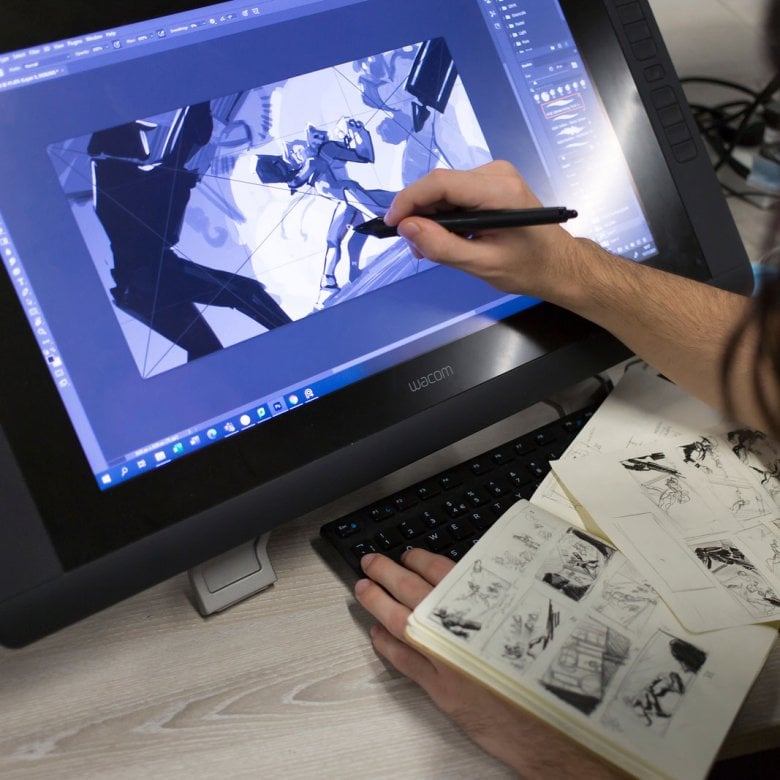Game Art lecturer on character creation and collaboration
16 September 2025

We chatted with senior lecturer in Game Art, Michael Boylan, on how games are almost never made in isolation. Collaboration, communication and hands-on experience are central to his teaching in the Games Academy. After decades working across Europe on some of the world’s best-known franchises, he now helps students test their skills in industry-standard pipelines, within an environment that encourages bold ideas and teamwork.
You’ve worked at some of the most recognisable studios across Europe, including Eurocom, NaturalMotion and MADFINGER. Which projects stand out most and why?
I wouldn’t necessarily say the studios themselves were the most recognisable, but they did work on some of the most iconic franchises, such as Harry Potter and James Bond. The companies I worked for were contracted by major players including Warner Bros, Disney, MGM and Google. The project that stands out most for me is actually the first game I worked on: SpeedFreaks (known as SpeedPunks in the US). We had an incredible team of passionate developers who were pushing the technical and artistic limits of the PlayStation 1. Many of those team members have gone on to have highly successful careers in games, research and film.
Some of Michael's work can be found below.
How have you seen character art evolve?
Character art has evolved dramatically since I started in the industry. I began working on the PlayStation 1, which was designed with 3D graphics at its core: a revolutionary shift for many of my colleagues who came from a 2D background. Even with characters limited to just a few hundred polygons, it required new skills and techniques. Since then, we’ve seen exponential growth in polygon counts and texture resolutions, the introduction of high-resolution geometry baking and normal maps, and the rise of PBR (Physically Based Rendering). Motion capture, once exclusive to film, became standard in games. Tools such as Unreal Engine and Metahuman, and technologies like VR/XR, have further transformed the landscape. The merging of real-time game tech with film production is especially exciting, and it’s this constant evolution that keeps me passionate about character creation.
What did working across so many roles – modeller, animator, pipeline lead, Character Art lead – teach you about collaboration in game production?
Games are almost never made in isolation. Learning to work effectively in a team is absolutely essential. If you need proof, just look at job postings on ArtStation or LinkedIn: “team player” is consistently listed as a key requirement. And it’s not just corporate jargon: a team that collaborates well is almost always more productive. That ethos is reflected in how we structure our teaching and projects at GA, where we emphasise teamwork and communication as core professional skills.
What’s something about working as a character artist that aspiring students often underestimate?
The sheer amount of hard work it takes, not just to learn the tools and pipelines but to stay current with constant software updates and emerging technologies. On top of that, there’s the artistic side: understanding anatomy is absolutely crucial. It’s a lot to absorb, but in my view, character art is one of the most rewarding disciplines in game development.
What drew you to lecture at Falmouth after years in the commercial games industry?
What really attracted me was Falmouth’s focus on “doing it for real”. University should be a place to grow both intellectually and professionally. The tools and disciplines we teach are all industry-standard, and my years in game development give me a strong foundation for teaching and assessing student work through the lens of a professional artist and character lead. And of course, the fact that it’s in Cornwall was a nice bonus.
What emerging skills should students be developing now to stay relevant in the industry?
That’s a tough one, because if I focus on software or character pipelines, the answer could change weekly. The pace of technological change makes it hard to predict specifics. But what won’t change are the fundamentals: strong artistic skills and the ability to judge what works in a project. Teamwork and communication will also remain essential, no matter how the tech evolves.
If you could give one piece of advice to a first-year student dreaming of becoming a character artist, what would it be?
Know that you’ve chosen something challenging, but incredibly rewarding. It takes hard work to reach your goals, and you’ll likely never feel completely confident in your work. That’s the eternal struggle of being an artist. But focus on the journey, not the destination. Do the best you can right now, and don’t give up.